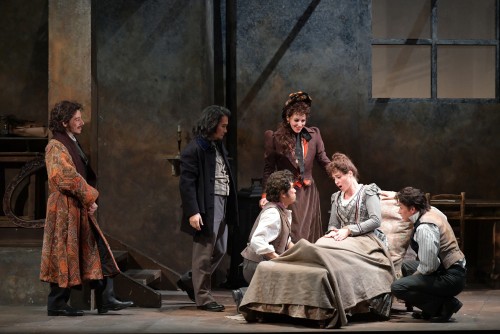An Impressionist painting faithful to the original, the opera ‘La Bohème'
 |
| A scene from ‘La Bohème' by New National Theater Tokyo/ Source: ⓒ Masahiko Terashi, New National Theater Tokyo |
New National Theater Tokyo (NNTT) of Japan celebrates its 25th anniversary, and the repertoire introduced over the past year is slowly coming to an end and is now preparing for a new season. The opera ‘La Bohème’, which will be performed from June 28th to July 8th, is the last opera of NNTT’s 25th anniversary program.
The 25th anniversary repertoire, presented over the 2022-23 season, alternately included new productions and meaningful re-performances and this opera is a re-stage of a work that was first premiered in 2003. It was surprising to see the potential to painstakingly recreate the production of 20 years ago.
This time "La Bohème" was conducted by Kazushi Ono, the artistic director of NNTT, and directed by renowned Japanese opera director Jun Aguni. Although Aguni Jun was the director of the production in 2003, but this was the first time under Ono's direction, so it was thought that it would not be exactly the same as 2003.
The Tokyo Philharmonic Orchestra, led by Ono, played at a relatively slow tempo. The music, which unfolds more leisurely than usual, was considered somewhat loose at first, but the deeper the lyricism was felt as it went later on. As if the notes drawn by Puccini were engraved one by one, the elaborately and delicately crafted music enveloped the stage and the entire theater and resonated brilliantly. In addition, the music matched the performance of the vocalist in detail, so it could be enjoyed with the pleasure of listening and watching and with the sense of security at the same time while appreciating the work. The vocalists on the stage were also in good harmony with the orchestra.
 |
| A scene from ‘La Bohème' by New National Theater Tokyo/ Source: ⓒ Masahiko Terashi, New National Theater Tokyo |
Tenor Stephen Costello is NNTT's preferred vocalist, who also appeared as a pinkerton in "Madame Butterfly" a few years ago. On this day, he sang the aria "Che gelida manina" of the first act perfectly with a splendid tone and stable breathing, and expressed Rodolfo brilliantly with his desperate acting skills. Alessandra Marianelli, who played Mimi, was a soprano with both innocence and rich volume. She sang ‘Sì, mi chiamano Mimi’ and the aria ‘Donde lieta uscì al tuo grido d'amore’ in Act 3 with her fluent phrasing her appealing singing voice.
In addition, soprano Valentina Mastrangelo in the role of Musetta and bass Francesco Leone in the role of Colline did their part well. And the choirs that filled the second act stage, including the New National Theater Choir and the Tokyo FM Boys Choir, also showed smooth performance and acting, enhancing the perfection of the work.
On the other hand, it was the spot in the sun that the song of Shingo Sudo, the baritone who played the role of Marcello, sounded weak. Shingo Sudo, one of Japan's leading opera singers, still showed good acting and expressiveness, but on this day, it was regrettable that Marcello's musical presence was not revealed due to his unclear vocalization.
 |
| A scene from ‘La Bohème' by New National Theater Tokyo/ Source: ⓒ Masahiko Terashi, New National Theater Tokyo |
Jun Aguni's stage was very basic and classic. Rodolfo's attic, cafe 'Momus', in front of the snowy inn, etc., were unfolded like the classic scenes of the traditional La Boheme stage. There was nothing new about the settings or stage. However, the director made full use of the atmosphere of the times with thorough historical evidence in many areas such as props and costumes.
For example, I got the impression that the paintings Marcello was working on were showing the impressionist painting style that was popular at the time, or that the bustling streets of Paris on Christmas Eve were making use of the realism of contemporary opera that Puccini pursued. In particular, Mimi was expressed as a woman in the paintings of French painter James Tissot.
Recently, while watching an opera, I often feel tired because of the excessive tendency of the Regie-Theater. It was often busy interpreting the meaning of the directing, and also in many cases necessary to accept the settings of work separately from music as if giving up. For that reason, NNTT's "La Bohème" which was faithful to the original work and music, was even more pleased. It was a satisfactory performance to wrap up the quarter century of New National Theater Tokyo, which has been walking sincerely.
Sooyeoun Sohn (Opera critic/ Professor at Dankook University)
 |
Translation: Daegon Wie
#La Bohème #New National Theater
Copyright by Asiatoday
Most Read
-
1
-
2
-
3
-
4
-
5
-
6
-
7





















